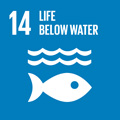- Docente: Elena Biagi
- Credits: 6
- SSD: ICAR/03
- Language: English
- Moduli: Elena Biagi (Modulo 1) Elena Biagi (Modulo 2)
- Teaching Mode: Traditional lectures (Modulo 1) Traditional lectures (Modulo 2)
- Campus: Ravenna
-
Corso:
Second cycle degree programme (LM) in
Science and Technologies for Environmental Sustainability (cod. 6055)
Also valid for Second cycle degree programme (LM) in Offshore Engineering (cod. 9249)
Second cycle degree programme (LM) in Offshore Engineering (cod. 9249)
-
from Sep 19, 2024 to Nov 28, 2024
-
from Dec 05, 2024 to Dec 05, 2024
Learning outcomes
The course will provide students with the knowledge of biochemistry, microbiology and bioprocessing required for the sustainable remediation of impacted marine ecosystems (surface and subsurface water and sediments) and the industrial exploitation of marine biodiversity and bioresources.
Course contents
Biodiversity and functions of the marine microorganisms
- Cellular organization, physiology, nutritional requirements and main features of marine bacteria, fungi and algae.
- Microbial metabolisms in the marine environment: photosynthesis; aerobic respiration, anaerobic respiration (nitrate-reduction, Fe(III)-reduction, sulfate-reduction, acetogenesis, methanogenensis), and fermentation of organic compounds; oxidation of inorganic compounds such as ammonium, sulfur, sulfide, iron(II).
- Microbial ecology of the marine (extreme) environment(s) and its monitoring.
Bioremediation of impacted marine ecosystems
- Common pollutants of the marine environment: classification, source, fate and environment impact.
- Marine microorganisms mainly involved in the biotransformation/biodegradation of organic pollutants and biochemical-molecular mechanisms responsible for their adaptation to the polluted environment.
- Biodegradation of oil hydrocarbons and halogenated xenobiotics in aerobic, surface and subsurface seawater and in anaerobic sediments.
- Strategies for the enhancement of aerobic and anaerobic bioremediation processes in the surface and subsurface seawater and in marine sediments (pollutant mobilization and bioavailability enhancement, biostimulation with nutrients (N, P) or electron donors, bioaugmentation, bioelectrochemical approaches).
- Management and main strategies for the ex-situ and in-situ (bio)remediation of contaminated sediments.
-Valorization of remediated or non contaminated dredged sediments.
Exploitation of marine bioresources
- Bioactive compounds for pharmaceutical, nutraceutical, cosmetic, agrochemical applications from marine bacteria, fungi, micro- and macroalgae and cyanobacteria;
- functional food ingredients from marine microbes, macroalgae and fish;
- pigments and colorants for the food and cosmetic industry from marine filamentous fungi;
- new enzymes from marine extremophiles;
- marine biofouling and ecofriendly biofouling prevention strategies based on marine microorganisms.
- the integrated production of chemicals, materials and fuels (biorefinery) from marine biomass and fish processing byproducts and waste;
-Biofuels from the exploitation of marine (micro)algae (biodiesel, algal biomass for combustion; biogas via anaerobic digestion of the biomass; biohydrogen; bioethanol via fermentation of carbohydrates derived from algae).
Readings/Bibliography
Madigan M.T. Martinko J.M., Stahl D.A., Clark D.P. (2012) Brock: Biology of Microorganisms. 14th Edition, Pearson, New York, USA
Munn C. (2011) Marine Microbiology. Ecology & Applications. 2nd Edition, Garland Science, Taylor & Francis Group, London, UK
Teaching methods
Class lectures in english supported by powerpoint slides
Assessment methods
Achievements will be assessed by the means of a final oral exam, through which the knowledge level acquired by the student on the topics covered in the class, his/her ability to present them clearly and with appropriate technical language and to discuss them critically will be evaluated.
Higher grades will be awarded to students who demonstrate an organic understanding of the subject, a high ability for critical application and connection between topics, and a clear and concise presentation of the contents.
To obtain a passing grade, students are required to at least demonstrate a knowledge of the key concepts of the subject and a comprehensible use of technical language.
A failing grade will be awarded if the student shows knowledge gaps in key-concepts of the subject, inappropriate use of language, and/or logic failures in the analysis of the subject.Teaching tools
Powerpoint slides used during lectures and other materials to help the student in organizing his/her study will be provided.
Office hours
See the website of Elena Biagi
SDGs




This teaching activity contributes to the achievement of the Sustainable Development Goals of the UN 2030 Agenda.
